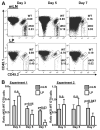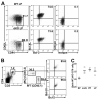The survival of memory CD4+ T cells within the gut lamina propria requires OX40 and CD30 signals
- PMID: 19786532
- PMCID: PMC3826117
- DOI: 10.4049/jimmunol.0901514
The survival of memory CD4+ T cells within the gut lamina propria requires OX40 and CD30 signals
Abstract
Although CD4(+) memory T cells reside within secondary lymphoid tissue, the major reservoir of these cells is in the lamina propria of the intestine. In this study, we demonstrate that, in the absence of signals through both OX40 and CD30, CD4(+) T cells are comprehensively depleted from the lamina propria. Deficiency in either CD30 or OX40 alone reduced CD4(+) T cell numbers, however, in mice deficient in both OX40 and CD30, CD4(+) T cell loss was greatly exacerbated. This loss of CD4(+) T cells was not due to a homing defect because CD30 x OX40-deficient OTII cells were not impaired in their ability to express CCR9 and alpha(4)beta(7) or traffic to the small intestine. There was also no difference in the priming of wild-type (WT) and CD30 x OX40-deficient OTII cells in the mesenteric lymph node after oral immunization. However, following oral immunization, CD30 x OX40-deficient OTII cells trafficked to the lamina propria but failed to persist compared with WT OTII cells. This was not due to reduced levels of Bcl-2 or Bcl-XL, because expression of these was comparable between WT and double knockout OTII cells. Collectively, these data demonstrate that signals through CD30 and OX40 are required for the survival of CD4(+) T cells within the small intestine lamina propria.
Figures





References
-
- Mowat AM, Viney JL. The anatomical basis of intestinal immunity. Immunol. Rev. 1997;156:145–166. - PubMed
-
- Reinhardt RL, Khoruts A, Merica R, Zell T, Jenkins MK. Visualizing the generation of memory CD4 T cells in the whole body. Nature. 2001;410:101–105. - PubMed
-
- Iijima H, Takahashi I, Kiyono H. Mucosal immune network in the gut for the control of infectious diseases. Rev. Med. Virol. 2001;11:117–133. - PubMed
-
- Strobel S, Mowat AM. Oral tolerance and allergic responses to food proteins. Curr. Opin. Allergy Clin. Immunol. 2006;6:207–213. - PubMed
Publication types
MeSH terms
Substances
Grants and funding
LinkOut - more resources
Full Text Sources
Molecular Biology Databases
Research Materials

